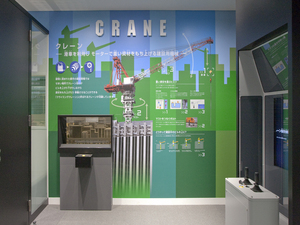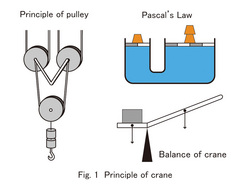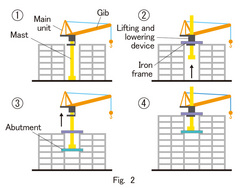Nagoya City Science Museum
TOP > Exhibition Guide > Floor Map> Crane
Crane

Purpose of Exhibition
A crane can hoist heavy loads, and move them around. It works very well at construction sites. We don't see cranes everywhere, but they are huge types of machinery that can sometimes be spotted. The purpose of this exhibit is to learn about the principle of mechanics for heavy load transportation, and the mysterious mechanism in which it seems like the crane moves up high-rise buildings by itself, and disappears without us realizing it after the building construction is done.


Additional Knowledge
<Mechanism of Lifting Heavy Loads: Pulley>
Using a combination of fixed and movable pulleys, a load can be lifted with a small force. Since the top of the crane is a combination of a fixed and movable pulley, it can hoist a heavy load easily (Fig.1).
<Mechanism of Lifting Heavy Loads>
It should be considered that a crane is based on moment principle. The back of the beam has a certain amount of weight, and it balances with the front of the beam which hoists the load. You can adjust the angle of the lifted load and the arm so that the load is lifted with a smaller force.
<Mechanism of Lifting Heavy Loads: Pascal's Law>
Pascal's law is used to operate a huge crane more than 3000t in total weight. Pascal's law states that pressure exerted anywhere in a confined incompressible fluid is transmitted equally in all directions throughout the fluid such that the pressure ratio (initial difference) remains same.
As shown in Fig.2, putting some pressure on an area, an equal amount of pressure is transmitted in all directions throughout the fluid. The equal pressure is also transmitted in a large part of area. But, force is multiplication of pressure and area. Thus, a stronger pressure is caused in a large part of area than that of a small area.
It is applicable to oil-pressure brakes and jacks. Pascal's law and its applied product may commonly be called and abbreviated "oil pressure" in a possible manner.
<Mechanism of Going up Buildings>
A crane can work on the very top of high-rise buildings under construction, and disappear at the completion of them before we realize it. It looks like it can climb up the buildings on its own.
(1) Construct buildings as high as possible with a jib climbing crane.
(2) Put iron frames over the top of the buildings, and pull up the mast with oil-pressure lifting and lowering device(3) Fix the lifted mast on the abutment, and the crane goes up along with the mast.
(4) By repeating this, the work can always be done on the very top of the buildings under construction.
Cooperation Takenaka CorporationArticle and illustration by Koichi Mabuchi
